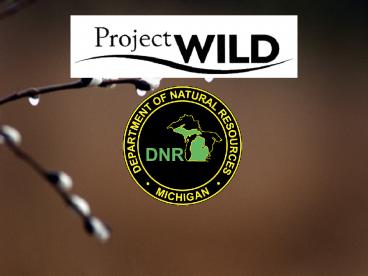Project WILD is: - PowerPoint PPT Presentation
1 / 26
Title:
Project WILD is:
Description:
Author: State of Michigan Last modified by: Raymond Alan Rustem Created Date: 11/14/2005 4:31:20 PM Document presentation format: On-screen Show Company – PowerPoint PPT presentation
Number of Views:99
Avg rating:3.0/5.0
Title: Project WILD is:
1
(No Transcript)
2
Project WILD is An award-winning,
interdisciplinary, conservation and environmental
education program that emphasizes wildlife and
its habitat.
3
To provide wildlife-based environmental education
that fosters responsible actions towards wildlife
and related natural resources.
The Mission
4
To provide wildlife-based environmental education
that fosters responsible actions towards wildlife
and related natural resources.
The Mission
To assist learners of any age in developing
awareness, knowledge, skills, and commitment that
will result in informed decisions, responsible
behavior, and constructive actions concerning
wildlife and the environment.
The Goal
5
Is Not!!
- Teaches Kids How to Think, Not What to Think
- Not a Wildlife Program
- Can Be Used in a Variety of Contexts Rural to
Urban - Works in Formal and Nonformal Settings
- Reputation for Balance and Breadth
6
Is!!
- An international network of students, educators,
parents, community leaders, educational
administrators, and representatives of resource
agencies and conservation groups. - A supplementary, interdisciplinary, instructional
program for educators of students in kindergarten
through high school.
7
- Ideal for integration into the teaching of
science, social studies, language arts, math,
art, physical education, health, music, and other
curriculum areas. - Appropriate for use by classroom teachers, as
well as resource specialists, naturalists,
rangers, scout and youth leaders, camp
counselors, and other nonformal educators. - A source of innovative techniques for teaching
basic skills. - Designed for diverse teaching and learning styles.
8
- Balanced and fair, neither pro nor con on
value-sensitive issues. - Concept-oriented.
- Effective for teaching problem solving and
decision making. - Extensively reviewed, tested, and evaluated.
- Praised by professional educators, wildlife
biologists, parents, and students. - Captivating education - its lively, hands-on
instructional strategies make learning fun!
9
Organization of Material in the Project WILD
Activity Guides
10
Section One Ecological Knowledge
Activities found in this section are
generally introductory lessons that focus on
awareness. They help develop a basis of
understanding for the characteristics of
environments and how they function.
11
Section One Areas of Study
- Wildlife Populations characteristics and
population dynamics - Habitats, Ecosystems, and Niches distribution
and importance of these habitats - Interdependence commonalties and interactions
among living things - Changes and Adaptations environmental changes
and organism adaptations - Biodiversity types of biodiversity, human
influence and the importance of habitat
12
Section Two
Social and Political Knowledge
This section builds on and moves the students
toward understanding. Students examine the way
human cultures, economics and politics have
affected peoples attitudes toward natural
resources.
13
Section Two Areas of Study
Cultural Perspectives cultural development,
expressions and appreciation of wildlife and
natural resources Economic, Commercial, and
Recreational Considerations Historical and
Geographic Development the development of
society and commerce as related to natural
resources Political and Legislative Frameworks
both domestic and international
14
Section Three
Sustaining Fish and Wildlife Populations
Activities found in this final section of the
book are generally higher level lessons that take
the students from understanding to action. The
activities are designed to serve as a way for
students to recognize, evaluate and make
responsible choices in their own lives regarding
natural resources while reflecting on the
knowledge and skills they have acquired in
earlier activities.
15
Section Three Areas of Study
Attitudes and Awareness including human
perspectives and values Human Impacts both
positive and negative Issues and Trends global
perspectives, land use, consumptive and
nonconsumptive uses of wildlife and wildlife
populations
16
Wildlife Management basic concepts related to
management considerations and practices Responsib
le Action and Service focusing on how students
and others can take action on behalf of wildlife
and the environment
17
Activity Components
Objectives Method Materials Background Sidebar -
Grade Level - Subject Areas - Duration - Group
Size - Setting - Framework Reference - Key
Terms - Appendices Procedure Extension Evaluation
18
Michigan Department of Natural Resources Michigan
Alliance for Environmental and Outdoor Education
(MAEOE) Michigan Chapter of the National Wild
Turkey Federation Rocky Mountain Elk Foundation
19
Magna Carta
Important Documents
Declaration of Independence
20
(No Transcript)
21
(No Transcript)
22
(No Transcript)
23
(No Transcript)
24
Workshop fees are sent to MAEOE
Forms and material requests sent to DNR
25
- For in the end, we will conserve only what we
love, - We will love only what we understand, and
- We understand only what we are taught
- Baba Dioum
- Central African Naturalist
26
Thank you
Great Lakes, Great Times, Great Outdoors
www.michigan.gov































